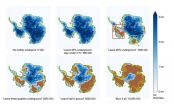Climate research: Where is the world's permafrost thawing?
The first global permafrost database goes online
2015-09-13
(Press-News.org) Bremerhaven (Germany), 14th September 2015. This Saturday at a conference in Quebec, Canada an international research team will present the first online data portal on global permafrost. In the Global Terrestrial Network for Permafrost researchers first collect all the existing permafrost temperature and active thickness layer data from Arctic, Antarctic and mountain permafrost regions and then make it freely available for download. This new portal can serve as an early warning system for researchers and decision-makers around the globe. A detailed description of the data collection is published today in an open access article on the Earth System Science Data portal.
Although the world's permafrost is one of the most important pieces in Earth's climate-system puzzle, to date it has been missing in most climate models. The reason: data on temperature and the active layer thickness were neither comprehensive nor were they available in a standard format suitable for modelling. With the new Global Terrestrial Network for Permafrost (GTN-P), scientists from 25 countries have now filled this gap in the data.
"If we want to understand the extent to which climate change is causing the permafrost to thaw and the effect this thawing will in turn have on our climate, we have to closely observe these regions around the globe, and we also have to make our measurements freely available.
This can only work if it is based on international cooperation, which we managed to achieve comprehensively for the first time in this project," explains database initiator Professor Hugues Lantuit, permafrost expert at the Alfred Wegener Institute, Helmholtz Centre for Polar and Marine Research (AWI).
Researchers measured the temperature of the permafrost by boring a hole in the frozen ground, inserting sensors and then reading the data on regular expeditions. "So far our database has brought together measurements from 1074 boreholes, 72 of which are in the Antarctic and 31 in the mountain regions of Europe and Asia. The remaining 961 measuring stations are distributed throughout the Arctic," says AWI researcher and GTN-P Director Dr Boris Biskaborn.
If you want to find out where the stations are located and what data is available, take a look at the GTN-P world map, where every borehole is marked with a flag. Clicking on the flag gives an instant overview of how cold the ice is below ground at this point and to what depth the ice melts in summer.
Anyone interested in downloading the data only has to register on the database once and agree to the terms and conditions. They then have free access to the time series. "The data is freely available, so that not only academics, but also politicians, officials and other interested parties can access this information and use it as a basis for decision-making. In regions where houses, roads, railways or pipelines are built on thin permafrost, the thawing process can cause severe damage. Here the database can serve as an early warning system," explains Boris Biskaborn.
International climate research benefits from the database in two ways: "Firstly we're making global permafrost information available in a standard format, allowing it to be easily used in climate models. At the same time we have also analysed the distribution of the measuring stations using statistical methods and can now say in which permafrost regions new stations for measuring permafrost temperature and active layer thickness are most urgently needed in order to make global climate models more reliable," stresses Dr Vladimir Romanovsky, the Chair of the GTN-P Executive Committee, permafrost researcher at the University of Alaska Fairbanks and co-author of the article published today.
The International GTN-P team enters new temperature and active layer thickness measurements into the database after 12 months from the data acquisition. According to Boris Biskaborn, "This gives all contributing scientists the opportunity to first analyse and publish their results." Every two years, the GTN-P team will prepare a report on the state of global permafrost, including information on any changes.
INFORMATION:
GTN-P was developed under the leadership of the International Permafrost Association (IPA) and supported by the Global Climate Observing System (GCOS). The GTN-P database was developed by Arctic Portal in Akureyri, Iceland. The data is managed in close cooperation with the GTN-P Secretariat, which is based at the Alfred Wegener Institute's research centre in Potsdam, Germany. The database is funded by the European Union (FP7-ENV-2011, Grant Agreement no. 282700) as part of the permafrost research project PAGE21.
ELSE PRESS RELEASES FROM THIS DATE:
2015-09-12
Though national data suggest that women researchers are less likely to obtain independent research funding than men, a study published in the Journal of Women's Health found that male and female researchers at the Johns Hopkins University School of Medicine are funded at nearly the same rate.
Rita Rastogi Kalyani, M.D., M.H.S.; Hsin-Chieh Yeh, Ph.D.; Jeanne Clarke, M.D., M.P.H.; Myron Weisfeldt, M.D.; Terry Choi; and Susan McDonald, M.D., all of Johns Hopkins, authored the study.
Kalyani points out that, in recent years, Johns Hopkins has demonstrated a commitment to ...
2015-09-11
WASHINGTON (Sept. 11, 2015) -- The largest nationwide clinical trial to study high-dose resveratrol long-term in people with mild to moderate Alzheimer's disease found that a biomarker that declines when the disease progresses was stabilized in people who took the purified form of resveratrol.
Resveratrol is a naturally occurring compound found in foods such as red grapes, raspberries, dark chocolate and some red wines.
The results, published online today in Neurology, "are very interesting," says the study's principal investigator, R. Scott Turner, MD, PhD, director ...
2015-09-11
CORAL GABLES, Fla. (September 11, 2015) -- Researchers from the University of Miami and Harvard University address the challenges of effective universal health coverage in low- and middle-income countries, focusing on solving one of the most pressing issues: the care of chronic illnesses. Their suggestions, aimed at strengthening health care systems, include recommendations based on a "diagonal approach" for managing health care. Their report is published in the September issue of the journal Health Affairs.
The authors shared their findings on Wednesday, September 9, ...
2015-09-11
Washington, DC--New work from an international team including Carnegie's Ken Caldeira demonstrates that the planet's remaining fossil fuel resources would be sufficient to melt nearly all of Antarctica if burned, leading to a 50- or 60-meter (160 to 200 foot) rise in sea level. Because so many major cities are at or near sea level, this would put many highly populated areas where more than a billion people live under water, including New York City and Washington, DC. It is published in Science Advances.
"Our findings show that if we do not want to melt Antarctica, we ...
2015-09-11
Burning all of the world's available fossil-fuel resources would result in the complete melting of the Antarctic ice sheet, a new study to be published in Science Advances shows. The Antarctic ice masses store water equivalent to more than 50 meters of sea-level rise. The new calculations show that Antarctica's long-term contribution to sea-level rise could likely be restricted to a few meters that could still be manageable, if global warming did not exceed 2 degrees. Crossing this threshold, however, would in the long run destabilize both West and East Antarctica - causing ...
2015-09-11
A study conducted by biologists at UC San Diego has found that the Africanized honey bee--an aggressive hybrid of the European honey bee--is continuing to expand its range northward since its introduction into Southern California in 1994.
The study, published in this week's edition of the journal PLOS ONE, found that more than 60 percent of the foraging honey bees in San Diego County are Africanized and that Africanized bees can now be found as far north as California's delta region.
"Our study shows that the large majority of bees one encounters in San Diego County are ...
2015-09-11
Scientists have identified an ingeniously elegant brain circuit consisting of just five nerve cells that allows female crickets to automatically identify the chirps of males from the same species through the rhythmic pulses hidden within the mating call.
The circuit uses a time delay mechanism to match the gaps between pulses in a species-specific chirp - gaps of just few milliseconds. The circuit delays a pulse by the exact between-pulse gap, so that, if it coincides with the next pulse coming in, the same species signal is confirmed.
It's one of the first times ...
2015-09-11
Researchers from Lund University in Sweden have shown that well-developed eyes come at a surprising cost to other organ systems. The study involving Mexican cavefish shows that the visual system can require between 5% and 15% of an animal's total energy budget.
Researchers have long associated the presence of a well-developed brain with major energy consumption. This means that animals that develop advanced nervous systems require environments where this is possible. There has to be good access to nutrients, and every investment in an organ comes at a cost to some other ...
2015-09-11
WASHINGTON (Sept. 11, 2015) - A statement from American College of Cardiology President Kim Allan Williams Sr., M.D., FACC, regarding the National Institutes of Health stopping the SPRINT trial early after demonstrating the positive benefits of lower blood pressure control targets:
"About 70 million American adults have high blood pressure and only half of them have their condition under control. The preliminary data demonstrates why the cardiovascular community must continue to aggressively fight a condition that leads to stroke, kidney disease and heart problems for ...
2015-09-11
Washington, DC - September 11, 2015 - Periodontitis is a risk factor for heart disease. Now a team of researchers has shown that a periodontal pathogen causes changes in gene expression that boost inflammation and atherosclerosis in aortic smooth muscle cells. The research is published ahead of print in Infection and Immunity, a journal of the American Society for Microbiology.
The circumstantial evidence that led to this study was ample. The periodontal pathogen, Porphyromonas gingivalis, has also been found in coronary artery plaques of heart attack patients. And in ...
LAST 30 PRESS RELEASES:
[Press-News.org] Climate research: Where is the world's permafrost thawing?
The first global permafrost database goes online

